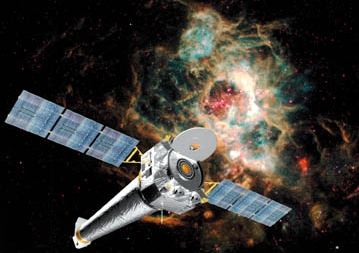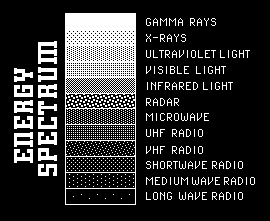| Chandra X-Ray Observatory | |||||
 |
|||||
|---|---|---|---|---|---|
| The third of NASA's Great Observatories for Space Astrophysics | |||||
| Chandra | Science | Spectrum | History | Resources | Great Observatories |
| Chandra X-Ray Observatory | |||||
 |
|||||
|---|---|---|---|---|---|
| The third of NASA's Great Observatories for Space Astrophysics | |||||
| Chandra | Science | Spectrum | History | Resources | Great Observatories |

The electromagnetic spectrum, extends from radio waves to gamma waves, from very low frequencies to extremely high frequencies. Our ability to tune in the more exotic radio waves has grown in recent decades.
In fact, it's only been in the 20th Century that we have used any radio, starting at the long-wave end of the spectrum. Today's AM broadcast stations transmit signals in the medium-wave portion of the spectrum. FM music stations use VHF transmitters.
TV stations use VHF and UHF. Cooking ovens are at microwave frequencies, as are police-speedtrap radar transmitters and receivers. All of these frequencies are part of the electromagnetic, or energy spectrum.
The visible light that we receive with our eyes is flanked in the spectrum by infrared and ultraviolet light we can't see. We do, however, have the capability to capture infrared light, ultraviolet light and X-rays on photographic film.
Deep Space Sensors. Only recently have we been able to make radio receivers and sensors, covering the UHF to gamma ray part of the electromagnetic spectrum, small enough and sensitive enough to send to space as part of orbiting telescopes. [spectrometers]
NASA has developed its set of four Great Observatories In Space to extend mankind's knowledge of astronomy and life itself. Each observatory has its own specialized instruments to gather data from its assigned part of the electromagnetic spectrum.Chandra's Energy Spectrum. Chandra has given scientists their first view of some of the most violent and energetic activities in the Universe. Compared with the red-green-blue visible light, which carry an energy of about 2 electron-volts and are seen through optical telescopes, Chandra sees energy ranging from 50 to 10,000 eV. That permits astronomers to photograph extraordinary activities taking place at faraway places across the Universe.
- Hubble sees visible light.
- Compton sees gamma rays.
- Chandra detects x-rays.
- The fourth, yet to be named commemoratively and launched, will see infrared energy.
The NASA diagram below reveals the portion of the electromagnetic spectrum viewed by Chandra X-Ray Observatory:
Frequency and Wavelength of Energy in the Electromagnetic Spectrum Energy Frequency in hertz Wavelength in meters gamma-rays 1020-1024 <10-12 m x-rays 1017-1020 1 nm-1 pm ultraviolet 1015-1017 400 nm-1 nm visible 4-7.5x1014 750 nm-400 nm near-infrared 1x1014-4x1014 2.5 um-750 nm infrared 1013-1014 25 um-2.5 um microwaves 3x1011-1013 1 mm-25 um radio waves <3x1011 >1 mm
Understanding Space Technology — Spectrometers
How the Radio Spectrum Works
Chandra Science Spectrum History Resources
Hubble Compton SIRTF Great Observatories Telescopes Deep Space
Search STO About STO Questions Suggestions Feedback E-Mail
© 2003 Space Today Online E-mail